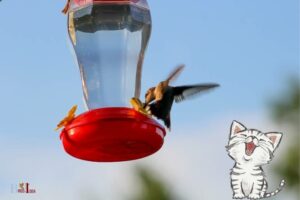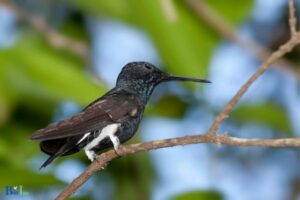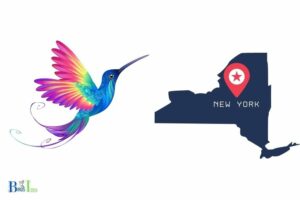How to Make Shade for Hummingbird Feeder? Step By Step
To make a shade for your hummingbird feeder, you’ll need a waterproof material like a plastic plate or canvas cloth, some string or wire, and a hook or clasp.
Attach the material above the feeder with the string or wire, ensuring it’s secure and won’t blow away in the wind
Hummingbirds are attracted to fresh, sweet nectar. When nectar is exposed to direct sunlight, it can quickly go bad and deter hummingbirds from visiting your feeder.
By creating shade for your hummingbird feeder, you are ensuring the nectar remains fresh and appealing to these delightful creatures.
To keep the feeder in full shade, you may want to combine two or more methods.
Additionally, you’ll want to make sure the canopy, umbrella, or awning is able to protect the feeder from wind and rain as well.
With the right shade, your hummingbird feeder will last longer and provide hours of enjoyment while attracting more hummingbirds.
10 Steps to Create Shade for Hummingbird Feeders
| Step Number | Instructions |
| 1 | Choose a location for your hummingbird feeder where it gets both sunlight and shade throughout the day. |
| 2 | Purchase a hummingbird feeder with a built-in shade or umbrella. |
| 3 | If your feeder does not have a built-in shade, you can create one using an umbrella or a similar tool. |
| 4 | Attach the shade or umbrella to a pole or a stand that is sturdy. |
| 5 | Position the shade or umbrella so that it casts a shadow over the hummingbird feeder. |
| 6 | Adjust the position of the shade or umbrella throughout the day to ensure that the feeder remains shaded. |
| 7 | Ensure the shade does not obstruct the view of the feeder for the hummingbirds. |
| 8 | Maintain the shade or umbrella in good condition to prevent it from falling or failing to provide shade. |
| 9 | Check regularly to make sure that the feeder remains in the shade during the hottest part of the day. |
| 10 | Make sure the feeder and the shade or umbrella are not in a windy area to avoid them being knocked over. |
Key Takeaway

Five Facts About: Making Shade for Hummingbird Feeders
DID YOU KNOW
Hummingbirds are migratory birds, meaning they travel long distances to new locations. According to the Department of the Interior, more than 20 species of hummingbirds are available to watch in the United States.
Why Is Shade Important for Hummingbird Feeders?
Shade is an important factor to consider when setting up a hummingbird feeder. Hummingbirds have delicate feathers and highly sensitive skin, making them vulnerable to the sun’s harsh rays.
Providing shade for your hummingbird feeder will help to protect the birds from the heat and direct sunlight.

Here are some benefits of providing shade for your hummingbird feeder:
- Enhances the birds’ comfort levels
- Keeps the nectar from becoming too hot
- Reduces evaporation of the nectar
- Helps block the wind, which can make the birds’ feeding difficult
- Provides protection from birds of prey
For example, you can place a sunshade umbrella over your hummingbird feeder to keep the birds cool and protected. The umbrella should be tall enough for the hummingbirds to fly beneath.
You should also aim to place the feeder in a shaded spot in the garden, such as beneath large trees or bushes. Doing so will provide the birds with a safe and comfortable place to feed.
Shade is a key factor to consider when setting up your hummingbird feeder. Not only will it help keep the birds cool, but it will also help protect them from the wind and predators.
Providing shade is an easy way to ensure that your hummingbirds are safe and comfortable while they feed.
How To Create Shade for a Hummingbird Feeder
Shade is essential to a hummingbird feeder, as it helps to protect the feeder from direct sunlight, rain, and other elements that can damage it.

Here are some tips for creating shade for your hummingbird feeder:
Use a cover or dome: This is the easiest way to create shade for a hummingbird feeder. Look for one that is made from a durable material such as metal or plastic, and attach it directly to the hummingbird feeder.
Hang the feeder from a tree: If the feeder is hung from a tree, it will naturally be shaded from the sun and rain. Make sure you hang it at least 8-10 feet off the ground so that it is safe from predators.
Place the feeder near a shrub or garden: Placing a hummingbird feeder near a shrub or garden will provide natural shade and protection from the sun and rain.
Install a shelter or canopy: If you want something more permanent, install a shelter or canopy over the feeder. This will provide protection from the sun, rain, and other elements.
Short example: If a hummingbird feeder is placed in a sunny area, the owner should consider installing a canopy or shelter to provide the necessary shade.
Creating shade for your hummingbird feeder is an important step in keeping it safe from the elements. By using these tips, you can ensure your feeder is properly shaded and protected.
“Creating the proper conditions for your hummingbird feeder will help ensure that you see more of these enchanting birds in your backyard.”
birdsidea
What Is the Best Way To Keep a Hummingbird Feeder in Shade?
The best way to keep a hummingbird feeder in shade is to hang it from a tree branch or other support that has some shade during the hottest part of the day.
Here are some tips to help you keep your hummingbird feeder in shade:

- Hang the hummingbird feeder in a tree that has some shade around mid-day.
- If you hang the feeder in an open space, use a sunshade or umbrella to provide some relief from the direct sunlight.
- If you have a balcony or patio, you can use a gazebo or sunshade to provide protection from the sun.
- Place the hummingbird feeder near bushes or other plants that can provide some shade.
It’s also important to clean the feeder regularly, as the sugar water can start to ferment if it’s in direct sunlight for too long. Cleaning the feeder every 3-4 days will help keep the hummingbirds healthy and happy.
For example, if you have a balcony, you can install a sunshade or umbrella to keep your hummingbird feeder in the shade.
This will help keep the hummingbirds cool and prevent the sugar water from fermenting. Additionally, you can hang the feeder in a tree that has some shade during the hottest part of the day.
Overall, the best way to keep a hummingbird feeder in shade is to hang it from a tree branch or other support that has some shade during the hottest part of the day.
Additionally, using a sunshade or umbrella, placing the feeder near plants, and cleaning the feeder regularly will also help keep the hummingbirds safe and healthy.
What Are The Benefits of Keeping a Hummingbird Feeder in Shade?
Keeping a hummingbird feeder in the shade has several benefits.
Here are a few:
Temperature:
Keeping a hummingbird feeder in the shade reduces the amount of direct sunlight, which helps to keep the nectar inside the feeder at a lower and more comfortable temperature.
This is beneficial to the hummingbirds as they don’t like to feed on nectar that is too hot.
Algae:
Keeping a hummingbird feeder in the shade reduces the growth of algae. Algae can form quickly in feeders and can spoil the nectar, making it unappetizing to the hummingbirds.
Visibility:
Keeping a hummingbird feeder in the shade can make it more visible to the birds. Hummingbirds are attracted to bright colors, so the feeder will be more noticeable if it is not in direct sunlight.
For example, you could hang the feeder from a tree branch near your patio. The shade from the tree will help keep the feeder at a comfortable temperature and make it more visible to the birds.
Overall, keeping a hummingbird feeder in the shade can help to protect the nectar from overheating and also reduce the growth of algae.
It can also make the feeder more visible to the hummingbirds, increasing the chances of them visiting your feeder.
What Do I Need To Know About Wind and Rain Protection When Creating Shade for a Hummingbird Feeder?
Creating a shade for a hummingbird feeder is an important part of providing a safe and comfortable environment for these birds.
It is essential to protect your feeder from the elements, such as wind and rain.
Here is what you need to know:

A good example of a weatherproof hummingbird feeder is the Aspects Hummzinger Ultra Hummingbird Feeder.
It has a hinged lid that is designed to keep out rain and debris, and can easily be secured to a post or other structure.
The feeder is also designed to be durable, so it can withstand strong winds and other weather conditions.
Overall, it is essential to consider wind and rain protection when creating shade for a hummingbird feeder.
Make sure the cover is secure and will not be blown away by high winds, and consider the location of the feeder to ensure it is in a sheltered area. Look for feeders that are designed to be weatherproof, such as the Aspects Hummzinger Ultra
How Can I Attract More Hummingbirds To My Feeder With Proper Shade?
Providing proper shade for a hummingbird feeder is important for attracting more of these small birds to the area.
It can help keep the feeder cooler and more inviting for the hummingbirds.
Here are some tips to attract hummingbirds with proper shade:

- Place the feeder in a spot that has shade from nearby trees.
- Consider adding an awning or umbrella over the feeder to provide extra shade.
- Position the feeder away from direct sunlight or in a spot that is protected from heat.
Creating a shaded spot for a hummingbird feeder can make it more inviting to these birds. Hummingbirds may be more inclined to visit the feeder if it is placed in a shaded area that is protected from direct sunlight and heat.
Additionally, making sure that the nectar inside the feeder doesn’t get too hot will help keep hummingbirds attracted to the area.
For example, providing a shady spot over the feeder with an umbrella or awning will help keep the feeder cool and inviting.
What Are The Benefits of a Longer-Lasting Hummingbird Feeder?
A hummingbird feeder is a great addition to any outdoor space, providing an enjoyable experience for watching these fascinating creatures.
A longer-lasting hummingbird feeder has many benefits that make it a great choice for anyone looking to attract these delightful birds to their yard.

The most obvious advantage of a longer-lasting hummingbird feeder is that it will need to be refilled much less frequently than a shorter-lasting one.
This saves time and effort, as you won’t need to constantly keep an eye on the feeder to make sure it’s full.
Additionally, the birds won’t have to compete with each other for food since there will be a more consistent supply available.
A longer-lasting hummingbird feeder also better protects the birds from the elements, since it won’t need to be taken down and put away as frequently.
This means they will be able to feed in a more comfortable, secure environment, leading to less stress and greater health benefits.
The most important benefit of a longer-lasting hummingbird feeder, however, is that it will provide a more enjoyable experience for both the birds and the people who watch them.
You can relax and observe the birds for longer periods of time, and they won’t have to worry about getting their food taken away by a human or another predator.
FAQ of How to Make Shade for Hummingbird Feeder
What materials are needed for making shade for a hummingbird feeder?
How large does the piece of wood need to be for making shade for hummingbird feeders?
How do I attach the shade fabric to the piece of wood?
How do I hang the hummingbird feeder with the shade in place?
What type of fabric should I use for the shade?
Conclusion
Creating shade for your hummingbird feeder is essential to ensure that the nectar in your feeder doesn’t spoil quickly in the sun.
Several options are available for providing shade, such as setting up a canvas canopy or an umbrella, or hanging the feeder from an overhead tree.
Combining several methods is an effective way to ensure full protection from the sun and other weather conditions.






